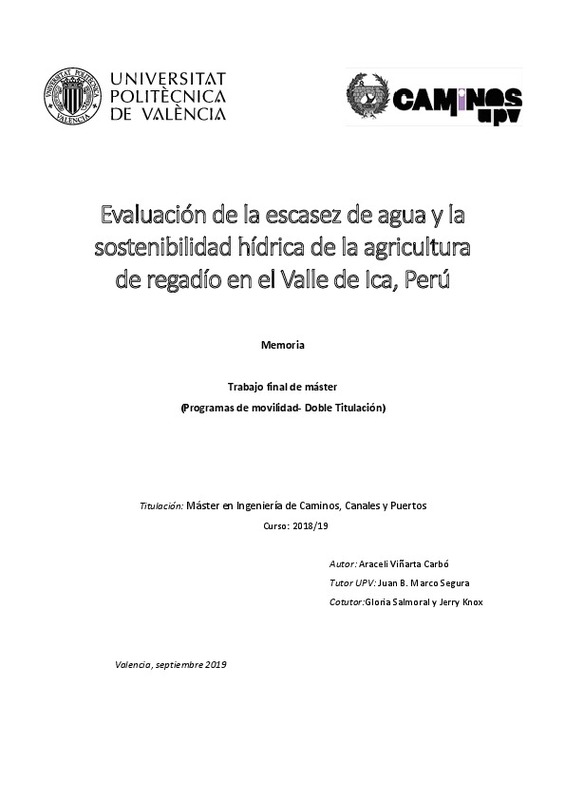|
Resumen:
|
[ES] El Valle del Ica ha sufrido una significante transformación y crecimiento, cuya producción actual contribuye aproximadamente a un tercio de la agroexportación total nacional. La expansión agrícola está teniendo lugar ...[+]
[ES] El Valle del Ica ha sufrido una significante transformación y crecimiento, cuya producción actual contribuye aproximadamente a un tercio de la agroexportación total nacional. La expansión agrícola está teniendo lugar a expensas de los recursos hídricos, tanto superficiales como subterráneos. Las abstracciones incontroladas de aguas subterráneas están provocando una sobreexplotación del acuífero Ica-Villacurí, la mayor reserva subterránea en Perú. Este estudio tiene el objetivo de valorar las necesidades hídricas del regadío en el Valle del Ica y evaluar los niveles de escasez de agua y sostenibilidad hídrica de la agricultura de regadío. En primer lugar, el estudio evalúa la situación actual, las tendencias históricas de los cultivos, la composición entre pequeñas y grandes áreas de cultivo, el comercio exterior, y las abstracciones de agua. Se estima la huella hídrica actual y futura, distinguiendo la procedencia del agua entre superficial y subterránea, para evaluar la escasez de agua y la sostenibilidad a través de los indicadores de estrés hídrico y deuda hídrica, respectivamente. Esta distinción de huella hídrica ligada a la procedencia del agua es particularmente novedosa puesto que este enfoque aún no se ha aplicado en Perú. Los resultados muestran que la huella hídrica subterránea es 1.5 veces mayor que la superficial. Se demuestra que la agricultura de regadío en el Valle del Ica tiene un potencial efecto negativo sobre los recursos hídricos, especialmente los subterráneos, dado que se ha estimado que muestran niveles moderados de estrés hídrico. Según las condiciones climáticas y los patrones de cultivo del 2017, la agricultura de regadío se considera localmente insostenible, puesto que 8 años son necesarios para reponer los recursos hídricos que son usualmente consumidos por la producción agrícola en un año. Por tanto, hay una necesidad urgente de incrementar la disponibilidad hídrica y/o mejorar la renovabilidad si se prevé continuar con el modelo actual de expansión y producción agrícola. En caso contrario, se impactarán negativamente tanto el suministro de agua en Ica, como los países que confían en Perú para importar frutas y verduras.
[-]
[EN] The Ica Valley in Peru has undergone significant agricultural transformation and growth, with current production contributing to approximately one third of the country’s total agro-exports. Agricultural expansion is ...[+]
[EN] The Ica Valley in Peru has undergone significant agricultural transformation and growth, with current production contributing to approximately one third of the country’s total agro-exports. Agricultural expansion is taking place at the expense of water resources, both surface and groundwater. Uncontrolled groundwater abstractions have led to over-exploitation of the Ica-Villacuri aquifer, the largest groundwater reserve in Peru. This research aimed to assess the irrigation water needs in the Ica Valley and evaluate levels of water scarcity and sustainability of irrigated agriculture. Firstly, the research evaluated the current situation and historical trends in cropped area, the composition of small and large-scale farms, export trade, and water abstractions. Historical and current blue water footprints (WF) were then estimated, distinguishing the water source between surface and groundwater, to assess water scarcity and sustainability through water stress and water debt indicators, respectively. This distinction of WF linked to source was particularly novel since this approach has not previously been applied in Peru. The results show that the groundwater footprint is 1.5 times higher than the surface water footprint. It has been demonstrated that irrigated agriculture in the Ica Valley has potentially a very detrimental effect on water resources (notably groundwater) given the moderate levels of water stress that were estimated. Based on climate conditions and existing cropping patterns from 2017, irrigated agriculture is considered to be locally unsustainable since 8 years are required to replenish the water resources that are typically being consumed by agricultural production in one year. There is thus an urgent need to either increase water availability and/or improve renewability if the current model of agricultural expansion and production is expected to continue. Otherwise, urban supply in Ica and the countries which rely on importing fruits and vegetables from this part of Peru are likely to be significantly negatively impacted.
[-]
|






